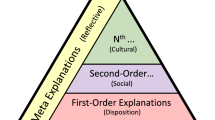Abstract
Vague predicates, those that exhibit borderline cases, pose a persistent problem for philosophers and logicians. Although they are ubiquitous in natural language, when used in a logical context, vague predicates lead to contradiction. This paper will address a question that is intimately related to this problem. Given their inherent imprecision, why do vague predicates arise in the first place? I discuss a variation of the signaling game where the state space is treated as contiguous, i.e., endowed with a metric that captures a similarity relation over states. This added structure is manifested in payoffs that reward approximate coordination between sender and receiver as well as perfect coordination. I evolve these games using a variation of Herrnstein reinforcement learning that better reflects the generalizing learning strategies real-world actors use in situations where states of the world are similar. In these simulations, signaling can develop very quickly, and the signals are vague in much the way ordinary language predicates are vague—they each exclusively apply to certain items, but for some transition period both signals apply to varying degrees. Moreover, I show that under certain parameter values, in particular when state spaces are large and time is limited, learning generalization of this sort yields strategies with higher payoffs than standard Herrnstein reinforcement learning. These models may then help explain why the phenomenon of vagueness arises in natural language: the learning strategies that allow actors to quickly and effectively develop signaling conventions in contiguous state spaces make it unavoidable.











Similar content being viewed by others
Notes
See recent work by Jeffrey Barrett, Andreas Blume, Michael Franke, Simon Huttegger, Gerhard Jäger, Martin Nowak, Christina Pawlowitsch, Robert van Rooij, and Kevin Zollman, for example.
For more on signaling games, see Skyrms (2010).
It might be taken as an objection to the models I present in this paper that they have only discrete state spaces, and thus cannot represent properties that vary continuously. In similar work, both Jäger (2007) and Komarova et al. (2007) appeal to the psychological notion of just-noticeable-differences in justifying the choice to treat continuous state spaces as discrete for modeling purposes. The choice here should best be understood as a simplifying assumption that allows for tractability while preserving the most important aspect of the state space in the models, its underlying similarity structure.
For more on how this may be accomplished see Krantz et al. (1971).
See, for example, Komarova et al. (2007).
These games are actually a subset of those outlined by Jäger (2007), whose model is much more general.
The results presented here are all for games where payoff is strictly decreasing in distance so as to avoid complicated cases. Note that the game shown in Fig. 3 has a strictly decreasing payoff function.
Note that this assertion applies only to games where each state of the world arises with equal probability, as is the case in all the games considered here. In games where some states are more likely to be selected by nature than others, the equilibrium results will be slightly different.
Jäger (2007) and Jäger et al. (2011) have proven very similar results in a more general class of games.
There are knife’s edge cases where a low level of mixing can exist as part of a payoff dominant Nash equilibrium of a CS game, but these are conceptually insignificant and will not be discussed here.
Lipman’s results are only applicable to cases of common interest signaling, i.e., those where the interests of the sender and receiver are perfectly aligned. Standard signaling games represent such cases because the sender and receiver always garner the same payoff, and thus always prefer the same outcomes. There are signaling games, however, where the interests of the players are not aligned, and it has been shown by Blume and Board (2013) and De Jaegher (2003) that in some of these cases vagueness may persist in equilibrium. However, real-world linguistic vagueness clearly includes cases where there is little or no conflict of interest between sender and receiver, so these models alone cannot explain the full phenomenon of vagueness.
For more on this, see Herrnstein (1970).
For a good review of dynamics used to investigate signaling games, including learning dynamics, see Huttegger and Zollman (2011).
And again, other strictly decreasing (and even just decreasing) functions yield similar qualitative results.
This measure is not perfect for the following reason. If two signals are synonyms, i.e., are used in exactly the same states, this measure will treat their overlap as vagueness. Synonyms are not typically taken as vague, however, because while they display overlap, they do not display borderline cases. The reason this measure is appropriate here is that the simulations considered do not exhibit high levels of synonymy.
De Jaegher and van Rooij (2011) and van Rooij (2011) have argued that vagueness can be strategically beneficial in that it allows for flexibility according to context. van Deemter (2009) and van Deemter (2010) have suggested various other potentially strategic explanations of vagueness as well, though none of these authors present game theoretic work. Franke et al. (2011) provide a model of the evolution of vagueness that will be discussed further shortly.
See Williamson (1994) for more on these and other philosophical positions on vaguenesss.
References
Barrett, J. A. (2009). The evolution of coding in signaling games. Theory and Decision, 67, 223–237.
Blume, A., & Board, O. (2013). Intentional vagueness. Erkenntnis. doi:10.1007/s10670-013-9468-x.
De Jaegher, K. (2003). A game-theoretic rationale for vagueness. Linguistics and Philosophy, 26, 637–659.
De Jaegher, K., & van Rooij, R. (2011) Strategic vagueness, and appropriate contexts. In A. Benz, C. Ebert, G. Jager, R. van Rooij (eds). Language, games, and evolution (pp. 30–59). Berlin, Heidelberg: Springer.
Franke, M., Jäger, G., & van Rooij, R. (2011). Vagueness, signaling and bounded rationality (pp. 45–59). Berlin: Springer.
Herrnstein, R. (1970). On the law of effect. Journal of the Experimental Analysis of Behavior, 13(2), 243–266.
Huttegger, S.M. (2007). Evolution and the explanation of meaning. Philosophy of Science, 74, 1–27.
Huttegger, S. M., & Zollman, K. J. S. (2011). Language, games, and evolution. In Signaling games: Dynamics of evolution and learning, (pp. 160–176). Berlin Heidelberg: Springer.
Huttegger, S. M., Skyrms, B., Smead, R., Zollman, K. J. S. (2010). Evolutionary dynamics of lewis signaling games: signaling systems vs. partial pooling. Synthese, 172, 177–191.
Jäger, G. (2007). The evolution of convex categories. Linguistics and Philosophy, 30, 551–564.
Jäger, G., Metzger, L.P., & Riedel, F. (2011). Voronoi languages: Equilibria in cheap-talk games with high-dimensional types and few signals. Games and Economic Behavior, 73(2), 517–537.
Komarova, N. L., Jameson, K. A., & Narens, L. (2007). Evolutionary models of color categorization based on discrimination. Journal of Mathematical Psychology, 51(6), 359–382.
Krantz, D. H., Luce, R. D., Suppes, P. & Tversky, A. (1971). Foundations of Measurement, vol 1. Mineola, NY: Dover Publications.
Lewis, D. K. (1969). Convention. Cambridge, MA: Harvard University Press.
Lipman, B. (2009). Why is language vague?.
Mednick, S. A., & Freedman, J. L. (1960). Stimulus generalization. Psychological Bulletin, 57(3), 169–200.
Pawlowitsch, C. (2008). Why evolution does not always lead to an optimal signaling system. Games and Economic Behavior, 63, 203–226.
Roth, A. E., & Erev, I. (1995). Learning in extensive-form games: Experimental data and simple dynamic models in the intermediate term. Games and Economic Behavior, 8, 164–212.
Skyrms, B. (2010). Signals: Evolution, learning, and information. Oxford: Oxford University Press.
van Deemter, K. (2009). Utility and language generation: The case of vagueness. Journal of Philosophical Logic, 38(6), 607–632.
van Deemter, K. (2010). Not exactly: In praise of vagueness. Oxford: Oxford University Press.
van Rooij, R. (2011) Vagueness and linguistics. In G. Ronzitti (Ed.), Vagueness: A guide. Dordrecht: Springer.
Williamson, T. (1994). Vagueness. New York: Routledge.
Author information
Authors and Affiliations
Corresponding author
Rights and permissions
About this article
Cite this article
O’Connor, C. The Evolution of Vagueness. Erkenn 79 (Suppl 4), 707–727 (2014). https://doi.org/10.1007/s10670-013-9463-2
Received:
Accepted:
Published:
Issue Date:
DOI: https://doi.org/10.1007/s10670-013-9463-2




